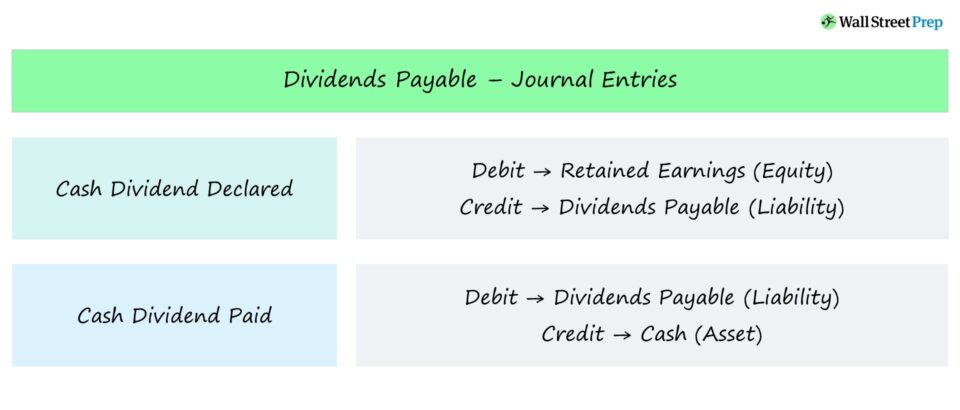What are Dividends Payable?
Dividends Payable is classified as a current liability on the balance sheet, since the expense represents declared payments to shareholders that are generally fulfilled within one year.

What is the Definition of Dividends Payable?
Once a proposed cash dividend is approved and declared by the board of directors, a corporation can distribute dividends to its shareholders.
The announced dividend, despite the cash still being in the possession of the company at the time of the announcement, creates a current liability line item on the balance sheet called “Dividends Payable”.
The treatment as a current liability is because these items represent a board-approved future outflow of cash, i.e. a future payment to shareholders. The carrying value of the account is set equal to the total dividend amount declared to shareholders.
However, note that a corporation is under no obligation to proceed with the dividend distribution if it decides otherwise is in the best interests of the shareholders, i.e. dividend payments are discretionary decisions, not a binding legal obligation like interest expense on debt.
What Type of Account is Dividends Payable (Debit or Credit)?
Cash dividends are paid out of a company’s retained earnings, the accumulated profits that are kept rather than distributed to shareholders.
The correct journal entry post-declaration would thus be a debit to the retained earnings account and a credit of an equal amount to the dividends payable account.
The important distinction here is that the actual cash outflow does not occur until the actual payment date.
On the initial date when a dividend to shareholders is formally declared, the company’s retained earnings account is debited for the dividend amount while the dividends payable account is credited by the same amount.
- Retained Earnings → Debited [Dr.]
- Dividends Payable → Credited [Cr.]
Therefore, the dividends payable account – a current liability line item on the balance sheet – is recorded as a credit on the date of approval by the board of directors.
Later, on the date when the previously declared dividend is actually distributed in cash to shareholders, the payables account would be debited whereas the cash account is credited.
- Dividends Payable → Debited [Dr.]
- Cash → Credited [Cr.]
What are Journal Entry Examples of Dividends Payable?
Suppose a corporation currently has 100,000 common shares outstanding with a par value of $10.
If the corporation’s board of directors declared a cash dividend of $0.50 per common share on the $10 par value, the dividend amounts to $50,000.
- Dividend = $0.50 × 100,000 = $50,000
The journal entry on the date of declaration is the following:
| General Ledger | Debit [Dr.] | Credit [Cr.] |
|---|---|---|
| Retained Earnings | $50,000 | |
| Dividends Payable | $50,000 |
As shown in the general ledger above, the retained earnings account is debited by $50,000 while the payables account is credited $50,000.
Once the previously declared cash dividends are distributed, the following entries are made on the date of payment.
| General Ledger | Debit [Dr.] | Credit [Cr.] |
|---|---|---|
| Dividends Payable |
$50,000 |
|
| Cash | $50,000 |
Since the cash dividends were distributed, the corporation must debit the dividends payable account by $50,000, with the corresponding entry consisting of the $50,000 credit to the cash account.

Everything You Need To Master Financial Modeling
Enroll in The Premium Package: Learn Financial Statement Modeling, DCF, M&A, LBO and Comps. The same training program used at top investment banks.
Enroll Today






Exlent explain
This is exactly the information I was looking for. So helpful. In my case it was decided to offset the dividend payable against an open receivable invoice. In this case I will credit the A/R instead of Cash. Right? Thank you very much!
Very good explanation just a little confused about the last part, Crediting the Cash account? Does this record the money leaving the business? I dont have a Cash account in my Chart of Accounts so do I just need to create one and is this basically cash removed from the… Read more »